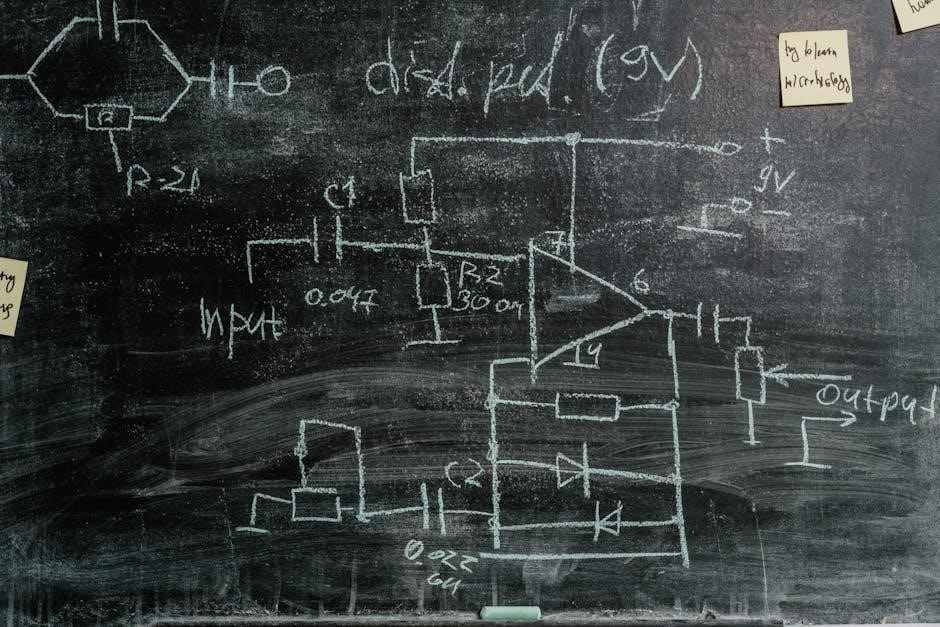Piping and Instrumentation Diagrams (P&IDs) are detailed schematics used in process control to represent equipment, instrumentation, and piping systems using standardized symbols, ensuring clarity and consistency in design and operation.
1.1 Definition and Purpose of P&IDs
Piping and Instrumentation Diagrams (P&IDs) are detailed graphical representations of process systems, illustrating equipment, piping, and instrumentation. They use standardized symbols to depict components like valves, sensors, and controllers. The primary purpose of P&IDs is to provide a clear, concise visual representation of a process, aiding in design, installation, operation, and maintenance. They ensure consistency, safety, and compliance with industry standards, serving as a critical communication tool for engineers, operators, and technicians across various industries.
1.2 Importance of Standardized Symbols in P&IDs
P&IDs rely on standardized symbols to ensure clarity and consistency. These symbols serve as a universal language for engineers and technicians, reducing errors and enhancing safety. They facilitate clear communication and collaboration among teams, ensuring everyone interprets the diagram correctly. Compliance with industry standards is maintained through these symbols, aiding in regulatory adherence. This consistency allows for efficient operation and maintenance, as well as effective training for new personnel, ensuring a smooth understanding of process control systems and contributing to overall system reliability.

Common P&ID Symbols and Their Meanings
Common P&ID symbols include instrumentation, valves, and equipment representations. Each symbol has specific meanings, ensuring clear process control and system functionality; Standardized symbols enhance diagram readability and consistency.
2.1 Instrumentation Symbols (e.g., Flow Meters, Pressure Sensors)
Instrumentation symbols represent devices measuring process variables like flow, pressure, and temperature. Flow meters indicate fluid movement, while pressure sensors monitor system force. These symbols are standardized to ensure clarity and consistency in P&IDs, enabling quick identification of device functions and their roles in process control. Standardization aids in understanding interactions between instruments and systems, ensuring accurate representation of process dynamics and enabling effective system design and operation.
2.2 Valves and Actuators (e.g., Gate Valves, Control Valves)
Valves and actuators are essential components in P&IDs, represented by standardized symbols. Gate valves are shown as rectangular boxes, while control valves include additional elements indicating regulation. Actuators, such as pneumatic or electric operators, are often combined with valve symbols to denote control mechanisms. These symbols clarify how valves operate within the process, ensuring precise communication of system functionality. Standardization ensures consistency, making it easier to interpret and implement process control strategies effectively.
2.3 Piping and Equipment Symbols (e.g., Tanks, Heat Exchangers)
Piping and equipment symbols are fundamental in P&IDs, representing physical components like tanks, heat exchangers, and piping routes. Tanks are often depicted as rectangular boxes with flat or rounded tops, while heat exchangers are shown as intertwined loops. Pumps and compressors are illustrated with circular or hexagonal shapes, sometimes with arrows indicating flow direction. These symbols, standardized in P&IDs, enable clear visualization of process layouts, ensuring accurate planning, installation, and operational safety. Their precise representation is crucial for effective process design and maintenance.
Key Components of a P&ID
P&IDs include process control systems, instrumentation, valves, piping, and equipment, with standardized symbols ensuring clear representation of process flows, connections, and operational controls for accurate system management.
3.1 Process Control Systems and Architecture
Process control systems in P&IDs illustrate the functional relationships between instruments, actuators, and equipment. These diagrams depict control loops, sensors, and actuators, showing how they interact to regulate process variables. The architecture is typically represented using standardized symbols, ensuring clarity in understanding complex systems. P&IDs also highlight communication pathways, such as electrical, pneumatic, or data signals, which are crucial for system operation. This structured representation enables effective troubleshooting and maintenance, ensuring seamless process control and optimization.
3.2 Tag Numbers and Their Significance
Tag numbers are unique identifiers assigned to components in P&IDs, ensuring clear identification and traceability. These numbers typically consist of letters and numbers, with the first letter indicating the measured property (e.g., F for flow, P for pressure). They link instruments, valves, and equipment to their specifications and locations, aiding in maintenance, troubleshooting, and operation. Consistent tag number formatting is crucial for clarity and efficiency in process control and documentation.
3.3 Signal Types (Electrical, Pneumatic, Data)
Signal types in P&IDs include electrical, pneumatic, and data signals, each representing different communication methods in process control. Electrical signals use voltage or current, while pneumatic signals rely on air pressure. Data signals, often digital, transmit information through protocols. These signals connect instruments, actuators, and control systems, enabling precise communication. Standardized symbols denote these signals, ensuring clarity. Accurate representation of signal types is crucial for troubleshooting, operation, and maintaining process efficiency, as they define how components interact within the system.

Best Practices for Creating P&IDs
Adhere to standardized symbols and layouts for clarity. Ensure consistency across diagrams and audit for completeness. Use tools like EdrawMax for precise symbol design and MicroStation for detailed drawings.
4.1 Standardization of Symbols and Layout
Standardizing symbols and layouts ensures consistency and clarity in P&IDs, reducing interpretation errors. Use ISO-compliant symbols, such as those from ISO 10628 and ISO 14617, to maintain uniformity across diagrams. Avoid customizing symbols excessively, as this can lead to confusion. Instead, rely on established libraries and tools like EdrawMax for precise symbol design and MicroStation .cel files for detailed drawings. A standardized layout improves readability and facilitates efficient communication among engineers and technicians.
Always include a legend sheet with your P&ID to define symbol meanings, ensuring everyone involved understands the diagram. This practice enhances collaboration and accuracy in process control systems. Use standardized templates and Grid-based layouts to organize components logically. Regularly update symbols to align with industry standards, ensuring diagrams remain relevant and effective for operational and maintenance purposes.
4.2 Clarity and Consistency in Diagrams
Clarity and consistency are essential for effective P&IDs. Ensure diagrams are free from clutter and use logical grouping of components. Consistently orient symbols to reflect real-world setups, avoiding ambiguity. Use color coding for signal types (e.g., electrical, pneumatic, data) to enhance readability. Maintain uniform font sizes and line thicknesses across the diagram. Regular audits and cross-referencing with legend sheets help verify accuracy. Consistency ensures all team members interpret the diagram correctly, reducing errors in process control and system maintenance;
4.3 Auditing and Ensuring Completeness
Auditing is crucial to ensure P&IDs are accurate and complete. Conduct regular reviews to cross-verify all components, symbols, and connections against project specifications. Check consistency in tagging and signal types, ensuring compliance with standards. Verify that all process control systems and instrument interactions are fully documented. Use standardized legend sheets and PDF references for validation; Address missing or ambiguous details promptly. Completeness ensures that diagrams accurately reflect the process, minimizing operational risks and facilitating efficient maintenance and troubleshooting.
Tools and Software for P&ID Creation
Essential tools include EdrawMax and Wondershare for symbol design, while MicroStation .cel files enable detailed drawings, ensuring precise and efficient P&ID development.
5.1 EdrawMax and Wondershare for Symbol Design
EdrawMax and Wondershare are popular tools for designing P&ID symbols, offering extensive libraries and customization options. These platforms provide drag-and-drop functionality, enabling users to create detailed diagrams efficiently. They support standard symbol creation, ensuring consistency and compliance with industry norms. Additionally, their user-friendly interfaces and collaboration features make them ideal for engineers and designers; These tools are essential for streamlining the symbol design process, ensuring accurate and professional P&ID representations.
5.2 MicroStation .cel Files for Detailed Drawings
MicroStation .cel files are essential for creating detailed P&ID drawings, providing precise artwork for symbols and components. These files contain standardized graphical representations, ensuring consistency across projects. They are used in conjunction with other libraries to maintain accuracy and scalability. MicroStation’s .cel files are crucial for complex piping and instrumentation designs, enabling engineers to produce high-quality, detailed diagrams efficiently. This tool is indispensable for ensuring precision and adherence to industry standards in P&ID creation.

Interpretation and Application of P&ID Symbols
P&ID symbols are fundamental for understanding system interactions. Combining symbols represents complex components, while actuator-instrument interactions ensure precise process control, adhering to standardized interpretations for functionality and safety.
6.1 Combining Symbols for Complex Components
Combining symbols in P&IDs allows for the representation of complex components and their interactions. For instance, symbol 2, when paired with actuators 20 and 21, denotes pressure safety valves. Similarly, symbols 1-14, combined with actuators 1-16, represent process control valves. This method ensures detailed and accurate documentation of intricate systems, facilitating better understanding and maintenance of process control functionalities. Proper interpretation of these combinations is essential for ensuring system safety and operational efficiency in industrial processes.
6.2 Understanding Actuator and Instrument Interactions
Actuators and instruments in P&IDs work together to control process systems. Actuators, such as control valves, execute commands from instruments, while instruments like pressure sensors provide feedback. Understanding their interactions is crucial for precise process control. For example, a pressure sensor (symbol 1) detects changes and sends signals to a control valve (symbol 2), which adjusts flow. Proper interpretation of these interactions ensures accurate system functionality, safety, and efficiency, making it vital for operators to grasp how these components collaborate in real-time process management.
Resources for P&ID Symbols
Access P&ID symbols through legend sheets in PDF format, online libraries, and software tools like EdrawMax and Wondershare. MicroStation .cel files provide detailed symbol artwork for precise drawings.
7.1 Legend Sheets and PDF References
Legend sheets and PDF references are essential resources for understanding P&ID symbols. These documents provide detailed visual representations and explanations of symbols, ensuring standardization; PDF files often include comprehensive libraries of symbols categorized by type, such as instrumentation, valves, and equipment. They serve as quick references for engineers and designers, promoting consistency. Additionally, ISO standards like ISO 10628 and ISO 14617 are frequently referenced in these PDFs, offering a unified approach to symbol usage across industries.
7.2 Online Libraries and Databases
Online libraries and databases provide extensive collections of P&ID symbols, accessible in PDF and other formats. Platforms like EdrawMax and Wondershare offer customizable symbol libraries for piping and instrumentation diagrams. These databases ensure standardized representations of components such as valves, instruments, and equipment. Engineers can download and integrate these symbols into their designs, promoting consistency and efficiency. MicroStation .cel files are also available, offering detailed artwork for precise drawings. These resources are indispensable for maintaining accuracy and compliance with industry standards like ISO 10628 and ISO 14617.
Piping and Instrumentation Diagrams (P&IDs) are essential blueprints for process systems, providing standardized symbols for clarity. They document components, control systems, and signal types, ensuring accurate communication. Engineers rely on resources like PDFs and online libraries for consistent design and compliance with industry standards, making P&IDs indispensable tools in engineering and operations.
8.1 Summary of Key Points
Piping and Instrumentation Diagrams (P&IDs) are critical tools for documenting process systems, using standardized symbols to represent equipment, valves, and instruments. They ensure clarity and consistency in design, operation, and maintenance. Key components include tag numbers, signal types, and process control systems. Tools like EdrawMax and MicroStation support symbol design and detailed drawings. Standardization, auditing, and clear layouts are best practices for creating accurate P&IDs. These diagrams are essential for effective communication and safety in industrial processes.
8.2 Future Trends in P&ID Symbol Standardization
Future trends in P&ID symbol standardization emphasize digitalization and integration with advanced tools like CAD software and cloud-based platforms; The adoption of IoT and AI in process control will drive demand for smarter, more interconnected symbols. Standardization efforts will focus on global consistency, reducing errors, and enhancing collaboration. Tools like EdrawMax and MicroStation will evolve to support dynamic, real-time updates. Additionally, sustainability and energy efficiency symbols will gain prominence, aligning P&IDs with modern industrial priorities and ensuring clarity in complex systems.
